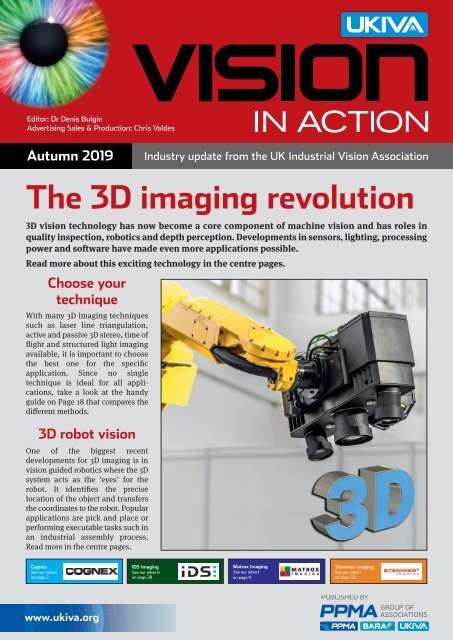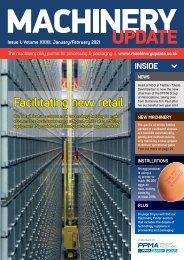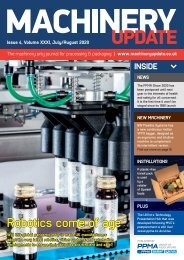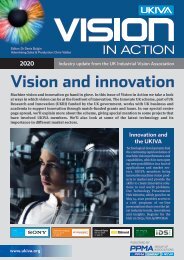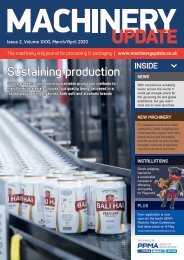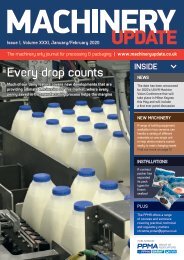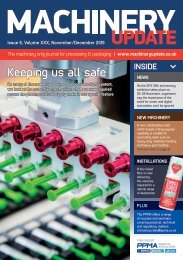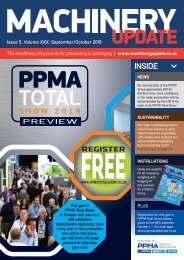Vision in Action Autumn 2019
Create successful ePaper yourself
Turn your PDF publications into a flip-book with our unique Google optimized e-Paper software.
Editor: Dr Denis Bulg<strong>in</strong><br />
Advertis<strong>in</strong>g Sales & Production: Chris Valde<br />
s<br />
<strong>Autumn</strong> <strong>2019</strong><br />
Industr<br />
y update from the UK Industrial <strong>Vision</strong> Association<br />
The 3D imag<strong>in</strong>g revolution<br />
3D vision technology has now become a core component of mach<strong>in</strong>e vision and has roles <strong>in</strong><br />
quality <strong>in</strong>spection, robotics and depth perception. Developments <strong>in</strong> sensors, light<strong>in</strong>g, process<strong>in</strong>g<br />
power and software have made even more applications possible.<br />
Read more about this excit<strong>in</strong>g technology <strong>in</strong> the centre pages.<br />
Choose your<br />
technique<br />
With many 3D imag<strong>in</strong>g techniques<br />
such as laser l<strong>in</strong>e triangulation,<br />
active and passive 3D stereo, time of<br />
flight and structured light imag<strong>in</strong>g<br />
available, it is important to choose<br />
the best one for the specific<br />
application. S<strong>in</strong>ce no s<strong>in</strong>gle<br />
technique is ideal for all applications,<br />
take a look at the handy<br />
guide on Page 18 that compares the<br />
different methods.<br />
3D robot vision<br />
One of the biggest recent<br />
developments for 3D imag<strong>in</strong>g is <strong>in</strong><br />
vision guided robotics where the 3D<br />
system acts as the ‘eyes’ for the<br />
robot. It identifies the precise<br />
location of the object and transfers<br />
the coord<strong>in</strong>ates to the robot. Popular<br />
applications are pick and place or<br />
perform<strong>in</strong>g executable tasks such <strong>in</strong><br />
an <strong>in</strong>dustrial assembly process.<br />
Read more <strong>in</strong> the centre pages.<br />
Cognex<br />
See our advert<br />
on page 2<br />
IDS Imag<strong>in</strong>g<br />
See our adverts<br />
on page 28<br />
Matrox Imag<strong>in</strong>g<br />
See our advert<br />
on page 9<br />
Stemmer Imag<strong>in</strong>g<br />
See our advert<br />
on page 32<br />
www.ukiva.org
3<br />
FOREWORD by Allan Anderson<br />
CONTENTS<br />
This issue of <strong>Vision</strong> <strong>in</strong> <strong>Action</strong> conta<strong>in</strong>s a special<br />
feature on 3D vision, which was once aga<strong>in</strong> a<br />
very popular topic at this year’s UKIVA Mach<strong>in</strong>e<br />
<strong>Vision</strong> Conference & Exhibition. This proved to be<br />
another resound<strong>in</strong>g success, with visitor numbers<br />
steadily <strong>in</strong>creas<strong>in</strong>g year on year. I’d like to thank the<br />
team at the PPMA who always do such a professional job <strong>in</strong> br<strong>in</strong>g<strong>in</strong>g the event<br />
to life. Mach<strong>in</strong>e vision is often described as an ‘enabl<strong>in</strong>g technology’ and there<br />
was plenty of evidence of that at the event. Across the 60 sem<strong>in</strong>ars offered by<br />
the Conference, a plethora of technologies and techniques were discussed to<br />
provide real food for thought for the highly engaged audience. However,<br />
noth<strong>in</strong>g is more compell<strong>in</strong>g than see<strong>in</strong>g the technology be<strong>in</strong>g used <strong>in</strong> real<br />
world applications and over 20% of the presentations did just that, with plenty<br />
of opportunity after the talks for attendees to discuss these applications <strong>in</strong><br />
more detail with the presenters. The exhibition also proved to be very popular,<br />
and we had more <strong>in</strong>ternational exhibitors than ever before who helped to<br />
create our biggest show of vision technology to date. Be<strong>in</strong>g co-located with the<br />
Conference, the exhibition is easily accessible to visitors throughout the day.<br />
Plann<strong>in</strong>g is already under way for the 2020 event, which will take places on<br />
14th May 2020, and aga<strong>in</strong> will be held at the Marshall Arena Milton Keynes UK.<br />
The 3D revolution cont<strong>in</strong>ues apace, and our 4 page centre page spread aims<br />
to highlight some of the latest developments and techniques and look at some<br />
of the many applications and markets for 3D imag<strong>in</strong>g, from robot vision to sag<br />
and hump <strong>in</strong>spection on roads. There is no doubt that 3D imag<strong>in</strong>g is tak<strong>in</strong>g off<br />
<strong>in</strong> a big way. Indeed more than 25% of the presentations at the Conference,<br />
<strong>in</strong>clud<strong>in</strong>g one of the Keynote addresses <strong>in</strong>volved some aspect of 3D vision. I<br />
hope you f<strong>in</strong>d this issue of <strong>Vision</strong> <strong>in</strong> <strong>Action</strong> both <strong>in</strong>terest<strong>in</strong>g and <strong>in</strong>formative!<br />
Allan Anderson, UKIVA Chairman<br />
Application Articles .................. 4-12<br />
Mak<strong>in</strong>g the most of 3D imag<strong>in</strong>g .. 15-18<br />
Product Updates .................... 20-29<br />
UKIVA Directory ......................... 30<br />
Events, Tra<strong>in</strong><strong>in</strong>g, Technical Tips .....30<br />
Free subscription contact<br />
Christ<strong>in</strong>e Valdes<br />
T: +44 (0) 20 8773 5517<br />
E: chris.valdes@ppma.co.uk<br />
We are always look<strong>in</strong>g to improve<br />
<strong>Vision</strong> <strong>in</strong> <strong>Action</strong>, for comments and<br />
feedback please email the editor<br />
Denis Bulg<strong>in</strong>, In Press PR Ltd<br />
E: denis@<strong>in</strong>press.co.uk<br />
Design and Artwork: Barry Heath<br />
E: bmh@bt<strong>in</strong>ternet.com<br />
Want to learn more about 3D?<br />
Download our Guide to<br />
3D Imag<strong>in</strong>g Techniques<br />
www.clearviewimag<strong>in</strong>g.co.uk/3d<br />
www.ukiva.org
4<br />
ASSOCIATION NEWS<br />
APPLICATION ARTICLES<br />
MORE STEM SUCCESS<br />
The latest vision-related STEM day for<br />
schoolchildren was run by Stemmer Imag<strong>in</strong>g and<br />
PPMA BEST (www.ppmabest.org.uk) at Ash Manor<br />
School, Ash, Surrey. Pupils <strong>in</strong> Year 8 had the<br />
opportunity to show their programm<strong>in</strong>g and<br />
structural eng<strong>in</strong>eer<strong>in</strong>g skills <strong>in</strong> a day dedicated to<br />
science, technology and maths. The pupils were<br />
split <strong>in</strong>to work<strong>in</strong>g groups of five to complete two,<br />
two-hour time trial challenges organised by<br />
eng<strong>in</strong>eers at Stemmer Imag<strong>in</strong>g. The w<strong>in</strong>n<strong>in</strong>g teams<br />
Editorial material <strong>in</strong> this section is provided by UKIVA Members.<br />
Content accuracy is the responsibility of <strong>in</strong>dividual UKIVA Members.<br />
ACROVISION<br />
www.acrovision.co.uk<br />
Deep Learn<strong>in</strong>g for the automotive Industry<br />
Increas<strong>in</strong>gly, <strong>in</strong>dustry is turn<strong>in</strong>g to deep learn<strong>in</strong>g technology to solve manufactur<strong>in</strong>g<br />
<strong>in</strong>spections that are too complicated, time-consum<strong>in</strong>g, and costly to program us<strong>in</strong>g<br />
traditional mach<strong>in</strong>e vision. Acrovision has been awarded 2 separate contracts to supply<br />
deep learn<strong>in</strong>g-based <strong>in</strong>spection systems <strong>in</strong>to the automotive sector. Both customers have<br />
requirements for multi-camera <strong>in</strong>spection to confirm that the correct part has been<br />
<strong>in</strong>stalled (based on colour or, model version) or to check for damage / scratches etc.<br />
Acrovision is us<strong>in</strong>g Cognex ViDi deep learn<strong>in</strong>g PC vision software to carry out these<br />
tasks. Cognex ViDi is the first deep learn<strong>in</strong>g-based software designed to solve these<br />
complicated applications for factory automation. Deep learn<strong>in</strong>g-based software can now<br />
perform judgment-based part location, <strong>in</strong>spection, classification, and character<br />
recognition challenges more effectively than humans or traditional mach<strong>in</strong>e vision<br />
solutions. A user-friendly front-end screen was also provided by Acrovision for operator<br />
<strong>in</strong>teraction. Learn<strong>in</strong>g technology uses neural networks which mimic human <strong>in</strong>telligence<br />
to dist<strong>in</strong>guish anomalies, parts, and characters while tolerat<strong>in</strong>g natural variations <strong>in</strong><br />
complex patterns. Deep learn<strong>in</strong>g offers an advantage over traditional mach<strong>in</strong>e vision<br />
approaches, which struggle to appreciate variability and deviation between very visually<br />
similar parts.<br />
Students f<strong>in</strong>d out more about vision<br />
were then <strong>in</strong>vited to spend a day at the company’s<br />
UK headquarters <strong>in</strong> Tongham, where they had a<br />
chance to f<strong>in</strong>d out much more about the<br />
capabilities that vision has to offer, as well as see<strong>in</strong>g<br />
some real systems <strong>in</strong> action.<br />
NEW MEMBERS GALORE!<br />
UKIVA cont<strong>in</strong>ues to grow and the<br />
Association is delighted to<br />
welcome Equipment Support<br />
Company, Genesi Elettronica and<br />
GS Controls as new members.<br />
Equipment Support Company is a specialist <strong>in</strong> PVD<br />
& vacuum process<strong>in</strong>g equipment, automation &<br />
control systems, vision<br />
systems and robotic pick &<br />
place solutions. They supply<br />
custom built technology and<br />
service support <strong>in</strong>to a wide<br />
range of <strong>in</strong>dustries. Genesi<br />
Elettronica designs and<br />
manufactures custom electronic cards and light<strong>in</strong>g<br />
for vision and <strong>in</strong>dustrial systems. GS Controls are<br />
experts <strong>in</strong> a wide range of<br />
mach<strong>in</strong>e controls and<br />
automation tasks <strong>in</strong>clud<strong>in</strong>g<br />
vision systems and product<br />
security. They service any<br />
<strong>in</strong>dustry requir<strong>in</strong>g automated<br />
production equipment. In<br />
addition, UKIVA member, FRAMOS, has created a<br />
new sister company called MaVis Imag<strong>in</strong>g to<br />
directly service the mach<strong>in</strong>e vision and <strong>in</strong>dustrial<br />
imag<strong>in</strong>g markets.<br />
www.ukiva.org<br />
Deep learn<strong>in</strong>g<br />
n Deep Learn<strong>in</strong>g-based software optimised for factory automation can:<br />
n Solve vision applications too difficult to program with rules-based algorithms<br />
n Handle confus<strong>in</strong>g backgrounds and poor image quality<br />
n Ma<strong>in</strong>ta<strong>in</strong> applications and re-tra<strong>in</strong> on the factory floor<br />
n Adapt to new examples without re-programm<strong>in</strong>g core algorithms<br />
n Be used by non-vision experts<br />
It represents a significant breakthrough <strong>in</strong> the <strong>in</strong>dustrial vision world, open<strong>in</strong>g up<br />
applications and tasks not previously achievable with traditional vision.
5<br />
ALLIED VISION<br />
APPLICATION ARTICLES<br />
www.alliedvision.com<br />
Drone supports <strong>in</strong> flood and coastal protection<br />
The “Hug<strong>in</strong>” drone with a Manta G-917 on board is an automated reconnaissance system<br />
to support disaster response personnel. Heavy ra<strong>in</strong> and storms result<strong>in</strong>g <strong>in</strong> flood<strong>in</strong>g can<br />
overrun sewage capacities and allow rivers to burst their banks, often with disastrous<br />
results. Emergency responders must coord<strong>in</strong>ate aid and protection measures as<br />
efficiently as possible. S<strong>in</strong>ce affected areas are often <strong>in</strong>accessible, real-time data and<br />
images from the air, comb<strong>in</strong>ed when possible with further sensor data on the ground’s<br />
condition can provide valuable <strong>in</strong>formation.<br />
ASSOCIATION NEWS<br />
MORE VISITORS AT MVC<br />
The 3rd UKIVA Mach<strong>in</strong>e <strong>Vision</strong> Conference and<br />
Exhibition (MVC), held recently <strong>in</strong> Milton Keynes, has<br />
proved to be a great success, with visitor numbers up<br />
by 15% compared to 2018 and an outstand<strong>in</strong>g<br />
exhibitor satisfaction rat<strong>in</strong>g. In a post-event exhibitor<br />
survey, 100% of the respondents recorded<br />
satisfaction levels of ‘very good’ or ‘excellent’. Many<br />
exhibitors commented on the day that they’d had<br />
some very positive discussions with visitors with real<br />
world problems to solve. This was clearly endorsed<br />
by the results of the follow-up survey.<br />
14 May 2020<br />
Marshall Arena, Milton Keynes, UK<br />
The Conference cont<strong>in</strong>ues to be a powerful<br />
attraction, highlight<strong>in</strong>g visitors’ desire to learn.<br />
Average attendance at the sem<strong>in</strong>ars has grown by<br />
over 30% s<strong>in</strong>ce the <strong>in</strong>augural event <strong>in</strong> 2017. This<br />
year’s Conference offered more sem<strong>in</strong>ars than ever<br />
before across 8 presentation theatres, with the<br />
additional theme cover<strong>in</strong>g vision and robotics<br />
attract<strong>in</strong>g a lot of <strong>in</strong>terest. The Keynote<br />
presentations by Dr Luca Benedetti from Kudan and<br />
M<strong>in</strong>h-Tri Pham from W<strong>in</strong>now were extremely wellattended,<br />
gett<strong>in</strong>g the morn<strong>in</strong>g and afternoon<br />
sessions off to a great start. This year also featured<br />
the largest number of exhibitors to date, with a<br />
bigger <strong>in</strong>ternational cont<strong>in</strong>gent. This is a further<br />
encourag<strong>in</strong>g <strong>in</strong>dication that the <strong>in</strong>dustry as a whole<br />
sees the UK mach<strong>in</strong>e vision market as be<strong>in</strong>g<br />
important and worth pursu<strong>in</strong>g. The next MVC will<br />
take place on 14th May 2020 at the Marshall Arena<br />
Milton Keynes, UK.<br />
Hug<strong>in</strong> drone<br />
Eng<strong>in</strong>eers from the Institute of Flight Guidance at the Technische Universität<br />
Braunschweig (TUBS) and from the Institute for Mobile Mach<strong>in</strong>es and Commercial<br />
Vehicles, also at the TUBS developed the Hug<strong>in</strong> drone. An Allied <strong>Vision</strong> GigE <strong>Vision</strong><br />
Manta G-917 camera on board the drone delivers aerial images. The camera is equipped<br />
with a 1” Sony ICX814 CCD sensor with EXview HAD II technology and a resolution of 9.2<br />
megapixels for <strong>in</strong>spection of ground objects <strong>in</strong> f<strong>in</strong>e detail. The camera also has an<br />
ethernet connection, global shutter sensor technology and low weight.<br />
Depend<strong>in</strong>g on the external conditions, Hug<strong>in</strong> can rema<strong>in</strong> <strong>in</strong> the air for up to 30<br />
m<strong>in</strong>utes without recharg<strong>in</strong>g. Dur<strong>in</strong>g the flight, <strong>in</strong>dividual images are usually recorded<br />
from altitudes of 100 metres, depend<strong>in</strong>g on the application. These images are then<br />
processed to generate a cont<strong>in</strong>uous overview of the entire application area. Due to the<br />
automatic exposure adjustment functionality of the camera, even chang<strong>in</strong>g light<br />
conditions are manageable. Information-rich camera pre-processed images are<br />
transmitted to the base station on the ground. These images help emergency responders<br />
to evaluate the situation more easily and quickly dur<strong>in</strong>g catastrophic events. The system<br />
has successfully been used <strong>in</strong> a number of test situations.<br />
RECORD ENTRIES FOR <strong>2019</strong><br />
PPMA VISION AWARD<br />
There has been a record number of submissions for<br />
the ‘Innovative <strong>Vision</strong> Solution’ category of the <strong>2019</strong><br />
PPMA Group awards. The follow<strong>in</strong>g companies<br />
have made it through to the f<strong>in</strong>als: Bytronic<br />
Automation, Cognex UK, CKF Systems, Conveyor<br />
Systems, Dimaco (UK), Hikvision, IDS Imag<strong>in</strong>g<br />
Development Systems,<br />
Lake Image Systems,<br />
Multipix Imag<strong>in</strong>g, Optel,<br />
Group, Scorpion <strong>Vision</strong> and<br />
Stemmer Imag<strong>in</strong>g. The<br />
award recognises an<br />
<strong>in</strong>novative vision solution<br />
that has led to a significant<br />
improvement <strong>in</strong> process, safety, quality, efficiency<br />
or cost sav<strong>in</strong>gs. An <strong>in</strong>dependent judg<strong>in</strong>g panel will<br />
be look<strong>in</strong>g for clever and creative approaches to the<br />
problem and the best productivity outcome. The<br />
w<strong>in</strong>ner of the award will be announced at the<br />
Awards Gala d<strong>in</strong>ner to be held on Tuesday 1st<br />
October <strong>2019</strong>.<br />
www.ukiva.org
APPLICATION ARTICLES<br />
7<br />
ALRAD IMAGING<br />
www.alrad.co.uk<br />
Beer bottle label alignment and<br />
position <strong>in</strong>spection<br />
The <strong>in</strong>spection of the label alignment, bottle cap, bottle neck and head as well as<br />
<strong>in</strong>spection for scratches, cracks and contam<strong>in</strong>ation is an important requirement for<br />
producers of bottled beer. Alrad Imag<strong>in</strong>g’s EVT Label Alignment and Position Inspector<br />
checks the position and the alignment of the label us<strong>in</strong>g parameters def<strong>in</strong>ed by the user.<br />
The system is easily retrofitted and can be <strong>in</strong>tegrated <strong>in</strong>to an exist<strong>in</strong>g tracker system to<br />
tell the system when to start the image capture and <strong>in</strong>spection process. The result of the<br />
label alignment <strong>in</strong>spection is put <strong>in</strong>to the evaluation wait<strong>in</strong>g list. In case of a faulty<br />
label, the bottle will be removed at the reject position.<br />
The Label Alignment Inspector is flexible and the user can add new criteria and<br />
characteristics to the <strong>in</strong>spection program to adjust it to new requirements. This means<br />
that code read<strong>in</strong>g (bar code, DMC, QR) and OCR as well as colour <strong>in</strong>spection can be<br />
immediately added to the application. The software can run on an emSys <strong>in</strong>dustrial<br />
computer which has Ethernet and USB connectors for cameras and four <strong>in</strong>dependent<br />
LED connectors. In this way the illum<strong>in</strong>ation can also be adjusted us<strong>in</strong>g the <strong>in</strong>spection<br />
program. The system can be used both with glass and PET bottles.<br />
Label alignment <strong>in</strong>spection on beer bottle<br />
CREST SOLUTIONS<br />
www.crestsolutions.ie<br />
Vial counters improve pack<strong>in</strong>g process<br />
Crest Solutions designed, built, <strong>in</strong>stalled and validated 4 new vial counter mach<strong>in</strong>es for<br />
a global pharmaceutical manufacturer’s biologics operations. The equipment is used<br />
to give accurate counts of product <strong>in</strong> vials immediately after fill<strong>in</strong>g/capp<strong>in</strong>g/crimp<strong>in</strong>g;<br />
and aga<strong>in</strong> later post-<strong>in</strong>spection before f<strong>in</strong>al labell<strong>in</strong>g and packag<strong>in</strong>g. The vial counters<br />
are free-stand<strong>in</strong>g, ergonomically-designed and cleanroom-grade compris<strong>in</strong>g mach<strong>in</strong>e<br />
body, electrical panel, <strong>in</strong>dustrial PC with <strong>in</strong>-built I/O module and strobe controller, 23”<br />
LCD touch screen display, sta<strong>in</strong>less steel keyboard, tray load<strong>in</strong>g platform and label<br />
pr<strong>in</strong>ter. The vision system uses a GigE camera with custom-built RGB dome light for<br />
image acquisition. Process<strong>in</strong>g is performed by a custom application built <strong>in</strong> Crest<br />
Solutions’ L<strong>in</strong>eDirector vision platform, built on Cognex <strong>Vision</strong>Pro 9.<br />
For future deployments a new job file is created for each cap colour and size<br />
comb<strong>in</strong>ation, but all other elements rema<strong>in</strong> standard. When an operator scans a work<br />
order, the software identifies the expected number of vials and compares this with the<br />
number detected <strong>in</strong> the image. If the count matches, then a label automatically pr<strong>in</strong>ts<br />
for application to the outer box. If the count doesn’t match, the operator is prompted to<br />
add/remove a set number of vials or attend to any knocked-over or upside-down vials<br />
detected, prior to re-test<strong>in</strong>g.<br />
The image acquisition/process<strong>in</strong>g result cycle time is around 1 second. All images<br />
and <strong>in</strong>teractions are stored <strong>in</strong> compliance with Data Integrity and CFR21 Part 11<br />
regulations. The vial counter ensures simple and accurate 100% batch reconciliation.<br />
It elim<strong>in</strong>ates the potential for human error with significant downstream implications <strong>in</strong><br />
an equivalent manual process and delivers time-sav<strong>in</strong>g efficiencies. Crest Solutions’<br />
Connect Academy created video SOPs to assist <strong>in</strong> operator tra<strong>in</strong><strong>in</strong>g and implementation<br />
of standard work for use of the vial counter mach<strong>in</strong>es.<br />
Vial counter<br />
IDS IMAGING DEVELOPMENT SYSTEMS GMBH<br />
www.ids-imag<strong>in</strong>g.com<br />
Compact 3D Robot Cell For B<strong>in</strong> Pick<strong>in</strong>g<br />
ALG Automatisierungslösungen GmbH together with its partner Nordfels Masch<strong>in</strong>enbau<br />
GmbH, has developed a “b<strong>in</strong> pick<strong>in</strong>g” robot cell to remove randomly placed components<br />
from a conta<strong>in</strong>er for process<strong>in</strong>g, with cycle times as short as 4 seconds per component.<br />
The cell has been used for a year <strong>in</strong> the Centre for Smart Manufactur<strong>in</strong>g <strong>in</strong> the Campus<br />
Wels of the University of Applied Sciences, Upper Austria. Students can work quickly<br />
and easily with the cell, learn new parts and change parameters for optimisation,<br />
mak<strong>in</strong>g it perfect for teach<strong>in</strong>g.<br />
Robot b<strong>in</strong> pick<strong>in</strong>g cell<br />
cont<strong>in</strong>ued on page 8<br />
www.ukiva.org
8<br />
APPLICATION ARTICLES<br />
14 May 2020<br />
Marshall Arena, Milton Keynes, UK<br />
The cell features a fast Denso robot, a powerful <strong>in</strong>dustrial PC and an Ensenso N35<br />
stereo 3D camera from IDS, all <strong>in</strong> comb<strong>in</strong>ation with powerful software. The 3D camera<br />
system is positioned approximately 1 metre above the conta<strong>in</strong>er. The stereo camera<br />
images the parts and generates a 3D po<strong>in</strong>t cloud of the surfaces <strong>in</strong> a s<strong>in</strong>gle image. This<br />
saves time compared to laser scann<strong>in</strong>g systems. The <strong>in</strong>tegrated FlexView projector<br />
technology enables very high accuracy of the po<strong>in</strong>t cloud and robustness of the 3D data<br />
from surfaces with little texture. Us<strong>in</strong>g a sophisticated “match<strong>in</strong>g procedure”, the<br />
algorithm recognises the <strong>in</strong>dividual components <strong>in</strong> the 3D po<strong>in</strong>t cloud.<br />
The system determ<strong>in</strong>es the part that is easiest and fastest to be picked up from the b<strong>in</strong><br />
and identifies the possible gripp<strong>in</strong>g po<strong>in</strong>ts. The robot controller also plans a collisionfree<br />
path for the robot arm. The parts are then safely taken and transferred to the<br />
subsequent process. This is achieved us<strong>in</strong>g a high-level language program <strong>in</strong> C# Visual<br />
Studio with <strong>in</strong>tegration of the HALCON image process<strong>in</strong>g library. A direct <strong>in</strong>terface<br />
between HALCON and Denso Robotics facilitates communication between image<br />
process<strong>in</strong>g and robot.<br />
O3D300 located above grade conveyor<br />
Wheat 3D po<strong>in</strong>t cloud<br />
www.ukiva.org<br />
IFM ELECTRONIC<br />
Automated log grad<strong>in</strong>g<br />
www.ifm.com/uk<br />
The Murray Timber sawmill <strong>in</strong> Galway processes thousands of logs per day, turn<strong>in</strong>g felled<br />
timber <strong>in</strong>to standard-sized pieces of usable raw material. The logs pass through a sorter<br />
after delivery to grade them <strong>in</strong>to different sizes accord<strong>in</strong>g to the amount of cuts that can be<br />
made. This determ<strong>in</strong>es the sizes and shapes of product can be made out of it. Automated<br />
grad<strong>in</strong>g should ensure a steady feed <strong>in</strong>to the mill to prevent it runn<strong>in</strong>g out of material.<br />
The natural variation <strong>in</strong> the log sizes ranges between 1.8 and 4.8m <strong>in</strong> length and 70 and<br />
700mm diameter. The previous sort<strong>in</strong>g solution used <strong>in</strong>dividual laser sensors, which due<br />
to environmental issues and low control resolution led to the conveyor not runn<strong>in</strong>g at full<br />
capacity, the <strong>in</strong>dividual grad<strong>in</strong>g b<strong>in</strong>s not be<strong>in</strong>g filled and a hold-up to the sawmill <strong>in</strong>feed.<br />
Murray Timber therefore <strong>in</strong>stalled an O3D300 3D-sensor from ifm electronic. This<br />
conta<strong>in</strong>s a light source and a s<strong>in</strong>gle chip based on ifm’s photonic mixer device technology,<br />
which is effectively over 23,000 <strong>in</strong>dividual time-of-flight sensors, all <strong>in</strong> a compact and<br />
rugged hous<strong>in</strong>g. The O3D300 acquires all the dimensional <strong>in</strong>formation <strong>in</strong> its field of view<br />
<strong>in</strong> a s<strong>in</strong>gle snapshot, measur<strong>in</strong>g the height of objects as well as length and width, whether<br />
they are mov<strong>in</strong>g or stationary. The sensor is <strong>in</strong>stalled above the logs, removed from the<br />
worst effects of the mechanical shock and with lenses shielded from the weather.<br />
Measurement data are transmitted via TCP/IP to an ifm AC14 PLC, allow<strong>in</strong>g the<br />
customer to track the log as it passes through the sort<strong>in</strong>g area and <strong>in</strong>sert another log as<br />
soon as the first log passes through the grader. The system can help to <strong>in</strong>crease<br />
throughput by 30% or more.<br />
MULTIPIX IMAGING<br />
www.multipix.co.uk<br />
NPL automates 3D imag<strong>in</strong>g of dense wheat crops<br />
The 3D technology of the Photoneo Phoxi scanner assists the NPL (National Physical<br />
Laboratory) to automate field phenotyp<strong>in</strong>g, a process of ga<strong>in</strong><strong>in</strong>g wheat measurement<br />
data, used to create a better variety of wheat and improve the yield. Phenotyp<strong>in</strong>g data<br />
is used to guide cross breed<strong>in</strong>g programmes for seed producers. Currently data is ga<strong>in</strong>ed<br />
manually with sample crops of wheat be<strong>in</strong>g measured by hand with a ruler. This time<br />
consum<strong>in</strong>g task takes many man hours with measurements be<strong>in</strong>g taken across<br />
hundreds of stems with<strong>in</strong> a plot; record<strong>in</strong>g the ear length, ear height, volume and<br />
spikelet numbers (number of gra<strong>in</strong>s per ear). These 4 ma<strong>in</strong> areas are recorded to give an<br />
<strong>in</strong>dication to the quality of the wheat and how much a seed variety could yield.<br />
The aim of the automated vision solution is to capture these 4 ma<strong>in</strong> plant traits out<br />
<strong>in</strong> the field with a mobile rig. The rectangular rig is fitted with 2 Phoxi Photoneo scanners<br />
capable of captur<strong>in</strong>g a standard sample area of 2 x 5 metres, with a turnround speed of<br />
30 seconds. The 3D po<strong>in</strong>t cloud <strong>in</strong>formation obta<strong>in</strong>ed from the structured light laser<br />
scanners is captured with millimetre precision. The multiple images are stitched together<br />
with post process<strong>in</strong>g of the cloud formation tak<strong>in</strong>g place with<strong>in</strong> MVTec’s Halcon Imag<strong>in</strong>g<br />
Software with NPL’s <strong>in</strong>-house algorithms. The Photoneo Phoxi was also chosen due to<br />
its ability to deal with the harsh outdoor conditions, <strong>in</strong>clud<strong>in</strong>g vary<strong>in</strong>g light, from bright<br />
sunsh<strong>in</strong>e to cloud. NPL will supply this service to seed producers, universities and<br />
research units work<strong>in</strong>g on the 250,000 research plots with<strong>in</strong> the UK.
What automotive vision<br />
teams have been look<strong>in</strong>g<br />
for all along.<br />
Matrox Design Assistant software offers an <strong>in</strong>tuitive, flowchart-based approach<br />
to mach<strong>in</strong>e vision application development. Hardware flexibility and effective<br />
vision tools make this software the right choice for error proof<strong>in</strong>g and track<strong>in</strong>g<br />
applications encountered <strong>in</strong> vehicle assembly and propulsion systems at major<br />
automotive manufacturers and similarly demand<strong>in</strong>g manufactur<strong>in</strong>g sectors.<br />
An efficient and powerful <strong>in</strong>tegrated development environment, it can deploy<br />
applications to various platforms—<strong>in</strong>clud<strong>in</strong>g the Matrox Iris GTR smart camera<br />
and Matrox 4Sight EV6 vision controller.<br />
Here is what’s new <strong>in</strong> Matrox Design Assistant X:<br />
New<br />
Matrox Design Assistant X<br />
• Inspection us<strong>in</strong>g classification based on deep learn<strong>in</strong>g technology<br />
• Photometric stereo tool to spot hard-to-see surface irregularities<br />
• Dedicated shape f<strong>in</strong>d<strong>in</strong>g tools to locate circles, ellipses, rectangles,<br />
and l<strong>in</strong>e segments<br />
• 3D sensor <strong>in</strong>terfac<strong>in</strong>g for process<strong>in</strong>g and analyz<strong>in</strong>g depth map data<br />
• Ability to run multiple <strong>in</strong>dependent projects on the same platform 1<br />
1. Platform permitt<strong>in</strong>g<br />
Learn more at www.matrox.com/imag<strong>in</strong>g/DA-X/ukiva
APPLICATION ARTICLES<br />
11<br />
SCORPION VISION<br />
3D post process<strong>in</strong>g of vegetables<br />
www.scorpionvision.co.uk<br />
Scorpion <strong>Vision</strong> contributes to the agritech sector where there is a big demand to post<br />
process fruits and vegetables as soon as they are harvested. One of the biggest challenges<br />
for the agri-food <strong>in</strong>dustry is the deplet<strong>in</strong>g workforce. 3D mach<strong>in</strong>e vision with colour and<br />
texture analyses can process fresh produce fast and accurately.<br />
A large proportion of people employed <strong>in</strong> the agri-food sector are seasonal<br />
agricultural workers who pick, sort, peel and cut the fruit and vegetables. This is hard<br />
work as they spend many hours do<strong>in</strong>g it, often <strong>in</strong> harsh, cold environments . The work<br />
also carries an above average statistic of <strong>in</strong>dustrial <strong>in</strong>jury, particularly where sharp<br />
knives are concerned.<br />
Scorpion <strong>Vision</strong> has recently developed 3D systems for post harvest vegetable<br />
process<strong>in</strong>g. These have been used for trimm<strong>in</strong>g swedes, leeks and sprouts. They use the<br />
new 3D Venom camera to identify the bits of the vegetable that should be cut, accurately<br />
measur<strong>in</strong>g the area to be removed and guid<strong>in</strong>g a robot to do so, reduc<strong>in</strong>g waste <strong>in</strong> the<br />
process.<br />
The 3D Venom is a s<strong>in</strong>gle camera that captures two images with disparity. The system<br />
works with a 12 bit dynamic range. The 3D FOV is approximately 250 x 200 mm with a<br />
depth resolution of 120 mm. It can be used for, 3D pose estimation, 3D shape verification,<br />
food grad<strong>in</strong>g and cutt<strong>in</strong>g applications. For leek trimm<strong>in</strong>g, a 2.3 MPixel colour camera<br />
with a white LED strobe is used to create the 3D model. For swede, a 6.0 MPixel colour<br />
camera with a white LED strobe is used.<br />
SICK (UK) LTD<br />
Quality Over A Barrel with 3D <strong>Vision</strong><br />
www.sick.co.uk<br />
Quality <strong>in</strong>spection of 10 and 20 litre barrels of HDPE barrels of soft dr<strong>in</strong>ks concentrate<br />
follow<strong>in</strong>g the automated fill<strong>in</strong>g and capp<strong>in</strong>g process is a critical step <strong>in</strong> production at a<br />
major <strong>in</strong>ternational beverage plant, before the sealed barrels are palletised and shipped<br />
to bottl<strong>in</strong>g facilities all over the world.<br />
Each cap has to be quality checked to confirm it is present and has been correctly<br />
screwed onto the barrel to the right level of torque. A new SICK 3D <strong>in</strong>spection system has<br />
replaced the previous 2D vision system, which required specialised illum<strong>in</strong>ation on two<br />
separate l<strong>in</strong>es to <strong>in</strong>spect the white plastic caps on white plastic barrels. A large box<br />
enclosure was needed to backlight each <strong>in</strong>spection and avoid <strong>in</strong>terference from ambient<br />
light. Even so, the system was unreliable and failed to elim<strong>in</strong>ate product leakage and<br />
customer rejects.<br />
The new system features SICK IVC3D smart cameras which use laser triangulation to<br />
create a complete and accurate profile <strong>in</strong> three dimensions. The cameras are mounted<br />
<strong>in</strong> the ideal position above the conveyor. The system <strong>in</strong>spects that each cap is present,<br />
that there is m<strong>in</strong>imal skew on the cap and that a tamper seal tab on the cap is orientated<br />
to <strong>in</strong>dicate that the correct amount of torque has been applied. Rejected barrels are<br />
diverted from the l<strong>in</strong>e, and each <strong>in</strong>spection is displayed on a l<strong>in</strong>eside screen, allow<strong>in</strong>g<br />
the production team to take appropriate further action.<br />
The system has been upgraded to accommodate batch changes between the 20 litre<br />
and smaller 10 litre barrels which have a lower height profile . This has been achieved<br />
through simple modifications to programm<strong>in</strong>g and has required no hardware<br />
modifications. The system automatically switches to new sett<strong>in</strong>gs with each batch change.<br />
3D process<strong>in</strong>g of swede<br />
3D image of cap on 20 litre drum<br />
14 May 2020<br />
Marshall Arena, Milton Keynes, UK<br />
www.ukiva.org
12<br />
APPLICATION ARTICLES<br />
HOTSPOT<br />
HOT GLUE INSPECTIO ON<br />
Integrated Mach<strong>in</strong>e<br />
<strong>Vision</strong> Solutions fo<br />
or<br />
the Smart Factory<br />
STEMMER IMAGING<br />
www.stemmer-imag<strong>in</strong>g.co.uk<br />
Integrat<strong>in</strong>g vision <strong>in</strong>to a manual<br />
assembly process<br />
Stemmer Imag<strong>in</strong>g and systems <strong>in</strong>tegrator Envisage Systems Ltd have<br />
developed a vision solution to <strong>in</strong>spect specialist water tub<strong>in</strong>g assemblies<br />
manufactured by Kautex Textron CVS Ltd. Around 12,000,000 tub<strong>in</strong>g<br />
assemblies <strong>in</strong> 200 variants are assembled manually each year. They are<br />
used on its Clear <strong>Vision</strong> Systems which keep vehicle headlamps or the<br />
cameras and sensors used <strong>in</strong> Advanced Driver Assistance Systems clean.<br />
Kautex is a top 100 Tier 1 supplier to global automotive OEMs, so quality is<br />
of paramount importance. S<strong>in</strong>ce the <strong>in</strong>troduction of the system there has<br />
been a 100% reduction <strong>in</strong> all targeted defects now measured by vision and<br />
100% traceability of every s<strong>in</strong>gle assembly <strong>in</strong>clud<strong>in</strong>g images. In addition<br />
there has been an approximately 70% reduction <strong>in</strong> the amount of<br />
paperwork be<strong>in</strong>g pr<strong>in</strong>ted for assembly purposes.<br />
Guarantee product quality<br />
Increasee production yield<br />
Protect your brand<br />
Avoid costly recalls<br />
Reduce<br />
manufactur<strong>in</strong>g loss<br />
s<br />
Intereste ed? Give us a call:<br />
+44 1564 793174 | bytronic.com<br />
Inspection system mounted above assembly fixture on workbench<br />
The vision system is <strong>in</strong>tegrated <strong>in</strong>to the manual assembly process so<br />
that product cannot physically be released to the next stage until the<br />
<strong>in</strong>spection is passed. Us<strong>in</strong>g a 5 Mpixel Genie Nano GigE <strong>Vision</strong> colour<br />
camera and a GEVA 300 compact vision processor runn<strong>in</strong>g Sherlock<br />
mach<strong>in</strong>e vision software, all from Teledyne DALSA, the system accesses<br />
the company’s SQL manufactur<strong>in</strong>g database for product documentation,<br />
manufactur<strong>in</strong>g data and staff competency <strong>in</strong>formation and transfers all<br />
<strong>in</strong>spection data for full assembly traceability. Systems are <strong>in</strong>stalled on 20<br />
workbenches, so any bench can be used for the assembly and <strong>in</strong>spection<br />
of any of the product variants. Us<strong>in</strong>g standard vision measurement tools<br />
the system can easily be adapted for new products. The system has now<br />
been adopted as a Kautex standard and will soon be rolled out to its US<br />
manufactur<strong>in</strong>g plant.
Mak<strong>in</strong>g the most of 3D imag<strong>in</strong>g<br />
15<br />
Although there have been massive technology developments <strong>in</strong> 3D imag<strong>in</strong>g, there is no ‘one size fits all’<br />
solution. Just as with any other mach<strong>in</strong>e vision requirement, the choice of technique is driven by the<br />
application. Factors such as the accuracy required, size of object be<strong>in</strong>g imaged, shape, surface properties,<br />
alignment, process<strong>in</strong>g time available, environmental conditions and, of course, budget must be carefully<br />
considered. In this special feature we take a look at the technology, techniques, applications and markets<br />
for 3D imag<strong>in</strong>g and give some po<strong>in</strong>ters on what fits best where.<br />
Emerg<strong>in</strong>g techniques<br />
As with all aspects of mach<strong>in</strong>e vision technology the world of 3D<br />
imag<strong>in</strong>g doesn’t stand still. Cont<strong>in</strong>uous developments and <strong>in</strong>novations<br />
open up new possibilities. Two of the newer developments are <strong>in</strong><br />
embedded systems and 3D through polarisation.<br />
Embedded systems<br />
Embedded vision has been a major topic <strong>in</strong> the vision <strong>in</strong>dustry for some<br />
time. It is often considered to be the direct <strong>in</strong>tegration of adapted camera<br />
modules <strong>in</strong>to mach<strong>in</strong>es or devices. Us<strong>in</strong>g bespoke computer platforms<br />
and lower power consumption, they do not require the use of an<br />
<strong>in</strong>dustrial PC. More recently, embedded 3D systems developed for the<br />
consumer electronics markets are be<strong>in</strong>g brought <strong>in</strong>to the mach<strong>in</strong>e vision<br />
arena. Most recently announced is the Sony DepthSense® time of flight<br />
sensor and before that the Intel® RealSense stereo vision sensors.<br />
Manufactured <strong>in</strong> volume quantites, they open up the use of 3D imag<strong>in</strong>g<br />
<strong>in</strong> high volume embedded applications <strong>in</strong> a wide variety of <strong>in</strong>dustries<br />
<strong>in</strong>clud<strong>in</strong>g retail, robotics and drones. This has been further realised<br />
through the development of <strong>in</strong>dustrial vision connectivity such as a<br />
GenICam Transport Layer. This allows the use of any GenTL-compliant<br />
software packages for further process<strong>in</strong>g and analysis which also<br />
provides the opportunity to develop <strong>in</strong>dividual GigE <strong>Vision</strong> camera<br />
versions.<br />
3D through polarisation<br />
Last year saw the launch of polarised cameras which use an on-chip<br />
polariser to detect the plane of light <strong>in</strong> 4 directions. Although polarisation<br />
cameras reveal <strong>in</strong>formation that cannot be seen us<strong>in</strong>g any other imag<strong>in</strong>g<br />
technique <strong>in</strong>clud<strong>in</strong>g physical properties such as stress or birefr<strong>in</strong>gence,<br />
they can also deliver 3D images. Us<strong>in</strong>g the ‘surface normal’ function of<br />
the polarised camera it is possible to detect different objects and the<br />
way light reflects off each surface and use this to either complement 3D<br />
image data, or act as a standalone alternative 3D system.<br />
3D Robot vision and Industry 4.0<br />
Here, the 3D vision system acts as the ‘eyes’ for the robot. The vision<br />
system identifies the precise location of the object and these coord<strong>in</strong>ates<br />
are transferred to the robot. With cont<strong>in</strong>ued improvements <strong>in</strong> camera<br />
resolution and highly advanced image process<strong>in</strong>g software, 3D robotic<br />
systems are becom<strong>in</strong>g more sensitive and powerful, enabl<strong>in</strong>g robots to<br />
recognise shapes, textures and 3D objects faster and more accurately.<br />
These advances mean fewer human overrides, vastly improved<br />
productivity and fewer product recalls. This, comb<strong>in</strong>ed with emergence<br />
of new vision-to-mach<strong>in</strong>e communications standards, means that there<br />
is enormous potential for 3D guided robots <strong>in</strong> the Industry 4.0 approach.<br />
Robot vision guidance (Couretsy Sick (UK))<br />
<strong>Vision</strong> – robot <strong>in</strong>terfaces<br />
The 3D system may either be postioned above the b<strong>in</strong> or conveyor belt,<br />
or actually located on the head of the robot. Whichever configuration is<br />
used, the vision system must be calibrated to real-world coord<strong>in</strong>ates and<br />
be able to map those coord<strong>in</strong>ates to the robot coord<strong>in</strong>ate system.<br />
Historically, vision-robot <strong>in</strong>terfaces have been complicated to set up, but<br />
massive strides have been made <strong>in</strong> this area recently to make the<br />
process easier. In some cases <strong>in</strong>terfaces are already built <strong>in</strong>to mach<strong>in</strong>e<br />
vision software packages, or if smart 3D cameras are be<strong>in</strong>g used there<br />
may be plug-<strong>in</strong>s available for different robots.<br />
Mak<strong>in</strong>g robots smarter<br />
The addition of 3D vision to robot operation confers an element of<br />
<strong>in</strong>telligence to the system, s<strong>in</strong>ce the vision system identifies the part that<br />
is easiest and fastest to pick up. In addition, vision allows a collision-free<br />
path to be calculated for mov<strong>in</strong>g the part to the required location. Of<br />
course <strong>in</strong> other areas of mach<strong>in</strong>e vision, deep learn<strong>in</strong>g and mach<strong>in</strong>e<br />
learn<strong>in</strong>g tools are be<strong>in</strong>g <strong>in</strong>creas<strong>in</strong>gly used, and systems have already<br />
been developed where the 3D data are evaluated by a convolutional<br />
neural network which looks at the scene, evaluates the objects and<br />
surfaces, and selects appropriate candidates for pick<strong>in</strong>g.<br />
3D <strong>in</strong>formation from polarisation camera<br />
(Courtesy Sony Image Sens<strong>in</strong>g Solutions)<br />
www.ukiva.org
16<br />
LIGHTING THE WAY TO 3D<br />
The four ma<strong>in</strong> 3D imag<strong>in</strong>g techniques, stereo vision,<br />
laser l<strong>in</strong>e triangulation, structured light and Time of<br />
Flight (ToF) use light <strong>in</strong> very different ways.<br />
Stereo vision<br />
Stereo vision replicates human vision by view<strong>in</strong>g a scene from two<br />
different positions us<strong>in</strong>g two cameras. Special match<strong>in</strong>g algorithms<br />
compare the two images, search for correspond<strong>in</strong>g po<strong>in</strong>ts and visualise<br />
all po<strong>in</strong>t displacements <strong>in</strong> a Disparity Map. S<strong>in</strong>ce the view<strong>in</strong>g angles and<br />
separation of the cameras is known, triangulation can be used to<br />
calculate the co-ord<strong>in</strong>ates of each pixel <strong>in</strong> the image to create a 3D po<strong>in</strong>t<br />
cloud. In passive stereo applications, the images are acquired us<strong>in</strong>g<br />
ambient light, but the quality of the resultant po<strong>in</strong>t cloud depends<br />
directly on both the light and object<br />
surface textures. Some applications<br />
therefore require active stereo vision,<br />
where a random light pattern of dots<br />
is projected onto the object surfaces<br />
to give a high-contrast texture and<br />
much better quality results.<br />
Laser l<strong>in</strong>e triangulation<br />
Here, a laser l<strong>in</strong>e is projected onto the<br />
surface of the object which moves<br />
beneath it. The l<strong>in</strong>e profile is distorted<br />
by the object and this is imaged by<br />
one or more cameras located at fixed<br />
distances and angles to the light<br />
surface. As the object moves under<br />
the l<strong>in</strong>e, the system builds up a series<br />
of profiles which represent the<br />
topology of the object. Aga<strong>in</strong> us<strong>in</strong>g<br />
triangulation methods, these profiles<br />
can be used to calculate the 3D po<strong>in</strong>t<br />
cloud.<br />
3D DATA PROCESSING<br />
Process<strong>in</strong>g 3D data and creat<strong>in</strong>g 3D images is<br />
computationally <strong>in</strong>tensive, and the evolution of high<br />
performance PCs was one of the key driv<strong>in</strong>g forces <strong>in</strong><br />
mak<strong>in</strong>g 3D imag<strong>in</strong>g an affordable ma<strong>in</strong>stream mach<strong>in</strong>e<br />
vision technique. Initially camera data was transferred to a<br />
PC, where the 3D po<strong>in</strong>t clouds were calculated and the<br />
various 3D measurements made. However the application<br />
of 3D imag<strong>in</strong>g to measure f<strong>in</strong>er details on faster <strong>in</strong>dustrial<br />
processes has required the use of higher resolution<br />
cameras at higher frame rates which generates larger data<br />
volumes that must be transmitted to the PC. The network<br />
bandwidth for data transmission to the PC must be<br />
optimised to avoid time delays or data loss. The process<strong>in</strong>g<br />
power of the PC hardware must also keep pace with the<br />
<strong>in</strong>creased process<strong>in</strong>g needs <strong>in</strong> order not to restrict the<br />
overall system.<br />
Mov<strong>in</strong>g data process<strong>in</strong>g<br />
The key to overcom<strong>in</strong>g these issues is to move the 3D data process<strong>in</strong>g<br />
away from the PC CPU. Today’s FPGA and multicore embedded<br />
processor architectures make it possible to do these calculations at<br />
much faster speeds. However, there may still be concerns about data<br />
transfer speeds to the PC, so there is an <strong>in</strong>creas<strong>in</strong>g move from camera<br />
Structured light<br />
Structured light, normally <strong>in</strong> the form<br />
of parallel l<strong>in</strong>es is projected onto the<br />
object. The distortion <strong>in</strong> the l<strong>in</strong>es<br />
caused by the shape of the object is<br />
captured by the camera and is used<br />
to calculate depth, structure and<br />
detail, by know<strong>in</strong>g the distance and<br />
angle between the projected light and<br />
the camera. This technique may be<br />
used with two cameras or a s<strong>in</strong>gle<br />
camera and is <strong>in</strong>dependent of the<br />
object’s texture.<br />
Time of flight<br />
In ToF systems the time taken for<br />
light emitted from the system to<br />
return to the sensor after reflection<br />
from each po<strong>in</strong>t of the object is<br />
measured. The direct ToF method<br />
(also known as pulse modulation)<br />
measures the return time of short<br />
pulses – this is longer the further<br />
away the imag<strong>in</strong>g po<strong>in</strong>t is from the<br />
sensor. The cont<strong>in</strong>uous wave<br />
modulation method uses a<br />
cont<strong>in</strong>uous signal and calculates the<br />
phase shift between the emitted and<br />
return<strong>in</strong>g light waves which is<br />
proportional to the distance to the<br />
object.<br />
www.ukiva.org<br />
3D Techniques<br />
(courtesy ClearView Imag<strong>in</strong>g)<br />
Mov<strong>in</strong>g process<strong>in</strong>g from PC to camera<br />
(Courtesy IDS Imag<strong>in</strong>g Development Systems)<br />
manufacturers to provide fast, direct memory access between image<br />
acquisition and process<strong>in</strong>g on a dedicated FPGA processor mounted<br />
either <strong>in</strong> the camera itself or <strong>in</strong> a separate module l<strong>in</strong>ked to the cameras,<br />
before transfer to a PC for further process<strong>in</strong>g. The transfer of 3D result<br />
data <strong>in</strong>stead of high-resolution 2D raw data significantly reduces the<br />
network load.<br />
Gett<strong>in</strong>g results<br />
For PC process<strong>in</strong>g, the major mach<strong>in</strong>e vision software packages offer an<br />
extensive range of 3D tools, beg<strong>in</strong>n<strong>in</strong>g with the construction of 3D depth<br />
maps or po<strong>in</strong>t clouds from any of the 3D imag<strong>in</strong>g techniques and system<br />
calibration. Other functionality typically <strong>in</strong>cludes 3D registration, 3D<br />
object process<strong>in</strong>g, surface-based 3D match<strong>in</strong>g and 3D Surface<br />
Inspection. These packages can handle multi-camera applications and<br />
smart cameras can also be l<strong>in</strong>ked for extended imag<strong>in</strong>g. Smart 3D<br />
cameras comb<strong>in</strong>e on-board process<strong>in</strong>g with a comprehensive range of<br />
measurement tools or application-specific packages, which means that<br />
they are completely self-conta<strong>in</strong>ed and do not need any ancillary PC<br />
process<strong>in</strong>g.
17<br />
3D APPLICATIONS 3D MARKET SECTORS (1)<br />
3D imag<strong>in</strong>g can be used <strong>in</strong> an enormous range of<br />
applications. Just some of these are outl<strong>in</strong>ed here:<br />
3D imag<strong>in</strong>g can be used <strong>in</strong> many different market sectors.<br />
Some examples are given here:<br />
Robot guidance<br />
Pick and place: transferr<strong>in</strong>g an object from one part of a process to<br />
another, often the objects have random orientation.<br />
Palletis<strong>in</strong>g and depalletis<strong>in</strong>g: plac<strong>in</strong>g goods on pallets at the end of<br />
manufactur<strong>in</strong>g or remov<strong>in</strong>g boxes from pallets or conveyors.<br />
B<strong>in</strong> pick<strong>in</strong>g: remov<strong>in</strong>g<br />
B<strong>in</strong> Pick<strong>in</strong>g often randomly placed<br />
(Courtesy Multipix items from b<strong>in</strong>s for<br />
Imag<strong>in</strong>g) further process<strong>in</strong>g.<br />
Packag<strong>in</strong>g: identify<strong>in</strong>g<br />
spaces <strong>in</strong> a box or rack as<br />
part of the robot pack<strong>in</strong>g<br />
processes, dimension<strong>in</strong>g<br />
and profil<strong>in</strong>g of multiple<br />
cartons/<br />
simultaneously.<br />
objects<br />
Automotive<br />
Pick and place; palletisation<br />
and depalletisiation; robot<br />
assembly; gap and flush,<br />
verify<strong>in</strong>g component surface<br />
f<strong>in</strong>ishes; position and size of<br />
sideframe mount<strong>in</strong>g holes;<br />
automotive part <strong>in</strong>spection;<br />
eng<strong>in</strong>e cradle <strong>in</strong>spection;<br />
w<strong>in</strong>dscreen <strong>in</strong>sertion; eng<strong>in</strong>e<br />
cyl<strong>in</strong>der and piston bowl<br />
volume gaug<strong>in</strong>g.<br />
Automotive component <strong>in</strong>spection<br />
Inspection<br />
Completeness checks: identify<strong>in</strong>g the presence or absence of parts <strong>in</strong> a<br />
component us<strong>in</strong>g depth <strong>in</strong>formation.<br />
Part manufactur<strong>in</strong>g <strong>in</strong>spection:<br />
verify<strong>in</strong>g shape, geometric and<br />
volumetric features for stamped<br />
items, mach<strong>in</strong>ed items, cast<br />
items (<strong>in</strong>clud<strong>in</strong>g the moulds),<br />
extrusions and 3D pr<strong>in</strong>ted parts.<br />
Component assembly: bead<br />
volume, geometry and location of<br />
adhesives, key tolerances such as<br />
tightness and flushness for<br />
fasteners, gap dimensions prior<br />
to weld<strong>in</strong>g, PCB measurement,<br />
measurement of solder height<br />
and location, check<strong>in</strong>g of rivet<br />
and screw hole locations,<br />
check<strong>in</strong>g of flushness between two<br />
parts.<br />
Product f<strong>in</strong>ish: check<strong>in</strong>g surface features.<br />
Packag<strong>in</strong>g <strong>in</strong>tegrity: check<strong>in</strong>g packag<strong>in</strong>g for correct seal<strong>in</strong>g and proper<br />
closure.<br />
Package fill<strong>in</strong>g <strong>in</strong>spection: verify<strong>in</strong>g correct package fill<strong>in</strong>g levels,<br />
underfill<strong>in</strong>g, overfill<strong>in</strong>g, measur<strong>in</strong>g negative space to see how much more<br />
can be added to a box.<br />
Measurements<br />
General quality control: measur<strong>in</strong>g length, width, height, depth, angles,<br />
hole diameters, angles, volume, orientation etc.<br />
Flow control: measur<strong>in</strong>g volume flow rate on a conveyor for process feed<br />
control.<br />
Portion<strong>in</strong>g: determ<strong>in</strong><strong>in</strong>g<br />
optimum cutt<strong>in</strong>g positions<br />
for portion<strong>in</strong>g based on<br />
volume.<br />
Sort<strong>in</strong>g: sort<strong>in</strong>g based on<br />
shape or size (may <strong>in</strong>volve<br />
robot pick<strong>in</strong>g on the basis<br />
of shape).<br />
OCR: read<strong>in</strong>g of raised<br />
characters such as DOT<br />
codes on tyres, braille,<br />
embossed characters.<br />
3D Inspection<br />
(Courtesy ClearView Imag<strong>in</strong>g)<br />
Fish Portion<strong>in</strong>g Us<strong>in</strong>g 3D<br />
(Courtesy Sick (UK))<br />
Navigation<br />
Distance measurements: Allows people monitor<strong>in</strong>g, obstacle avoidance,<br />
can be used on mobile robots.<br />
Consumer electronics<br />
Glue bead volume and uniformity <strong>in</strong>spection; trackpad flatness<br />
<strong>in</strong>spection. Cell phone <strong>in</strong>spections: hous<strong>in</strong>g holes; glass/bezel gap &<br />
flush; camera; solder paste; nano-SIM connector p<strong>in</strong>s; batteries; PCB<br />
and other assemblies; logo; connector test<strong>in</strong>g.<br />
Pharmaceutical<br />
Blister pack <strong>in</strong>spection, Pick and place of products/boxes <strong>in</strong>to larger<br />
packag<strong>in</strong>g.<br />
Dos<strong>in</strong>g volume levels <strong>in</strong>spection - how much powder/tablet size is<br />
present 3D Inspection for Totes <strong>in</strong> packag<strong>in</strong>g area - empt<strong>in</strong>ess check<strong>in</strong>g<br />
Check<strong>in</strong>g heights/dimensions of products - tables etc.<br />
Packag<strong>in</strong>g<br />
Package <strong>in</strong>spection before fill<strong>in</strong>g; kitt<strong>in</strong>g <strong>in</strong>spection; <strong>in</strong>spection of<br />
package seal<strong>in</strong>g; <strong>in</strong>tegrity and siz<strong>in</strong>g; palletisation and depalletisation;<br />
package/carton siz<strong>in</strong>g.<br />
ToF Pallet Stack<strong>in</strong>g (Courtesy Stemmer Imag<strong>in</strong>g)<br />
Food & beverage<br />
Size, shape, edge defects and thickness of bakery products such as<br />
bread, biscuits, pies, pasties, cakes and pizza, pick and place, check<strong>in</strong>g<br />
packaged products, portion control for bacon, cheese, ham etc to<br />
maximise on weight percentages and m<strong>in</strong>imise giveaway. Packag<strong>in</strong>g<br />
seal<strong>in</strong>g <strong>in</strong>tegrity and alignment for shelf life.<br />
Agriculture<br />
Fruit and vegetable harvest<strong>in</strong>g; fruit and vegetable trimm<strong>in</strong>g; animal<br />
health monitor<strong>in</strong>g; plant phenotyp<strong>in</strong>g.<br />
www.ukiva.org
18<br />
3D MARKET SECTORS (2)<br />
Transport & <strong>in</strong>frastructure<br />
Autonomous driv<strong>in</strong>g; road roughness and rutt<strong>in</strong>g; pavement edge<br />
condition; tyre-to-pavement contact area; sag and hump <strong>in</strong>spection;<br />
preventative ma<strong>in</strong>tenance for rail tracks.<br />
Rubber & tyre<br />
Rubber extrusion profil<strong>in</strong>g; strip guidance; splice control; layer control;<br />
bulge and dent; radial and lateral runout; tyre mark<strong>in</strong>gs; DOT-Code<br />
identification.<br />
General manufactur<strong>in</strong>g<br />
Pick and place; robot assembly; size; shape; volume; surface f<strong>in</strong>ish<br />
measurements for quality control; part to part comparison; part to CAD<br />
comparison.<br />
Wood<br />
Log optimisation <strong>in</strong> the sawmill; headrig applications; end-dogg<strong>in</strong>g<br />
applications;<br />
cant edger and gang saw optimisation; transverse board edg<strong>in</strong>g and<br />
trimm<strong>in</strong>g; f<strong>in</strong>ished lumbar grad<strong>in</strong>g; tracheid detection; quality control of<br />
gang lumber size mach<strong>in</strong>ery.<br />
Logistics<br />
Pallet management; collision avoidance; optimis<strong>in</strong>g space usage <strong>in</strong><br />
freight transport and warehous<strong>in</strong>g; real time track<strong>in</strong>g of resources and<br />
assets on the factory floor; shipp<strong>in</strong>g strategies; carton/object<br />
dimension<strong>in</strong>g and profil<strong>in</strong>g.<br />
Tyre DOT Code read<strong>in</strong>g (Courtesy Stemmer Imag<strong>in</strong>g)<br />
CHOOSING A 3D SYSTEM<br />
Each of the four ma<strong>in</strong> 3D imag<strong>in</strong>g techniques has performance characteristics that should be considered when evaluat<strong>in</strong>g<br />
a system for a particular application. All of these techniques have been used <strong>in</strong> robot vision applications.<br />
Stereo vision<br />
Stereo vision mimics human depth perception. Passive stereo vision<br />
requires well-textured surfaces with good light<strong>in</strong>g, but textureless<br />
surfaces and poor light<strong>in</strong>g conditions require active stereo vision us<strong>in</strong>g<br />
a random pattern light projector. With depth resolution to the millimetre<br />
level, the technique is good for co-ord<strong>in</strong>ate measurement and the 3D<br />
measurement of workspaces. It offers high accuracy <strong>in</strong> measur<strong>in</strong>g<br />
objects with a small work<strong>in</strong>g range. It benefits from hardware<br />
acceleration <strong>in</strong> production l<strong>in</strong>e applications.<br />
Laser Triangulation<br />
The laser triangulation method creates 3D shape profiles from laser l<strong>in</strong>e<br />
displacement. It requires the object to be mov<strong>in</strong>g <strong>in</strong> order to build up the<br />
3D model, but delivers very precise detail on even on surfaces with low<br />
contrast. Reflect<strong>in</strong>g or absorb<strong>in</strong>g surfaces can be more difficult. It works<br />
well at short distances and provides depth resolution at the µm level.<br />
Hardware acceleration is needed for high speed <strong>in</strong>l<strong>in</strong>e <strong>in</strong>spections.<br />
Structured Light<br />
Depth data is calculated from the displacement of light patterns by the<br />
object. With micron level depth resolution, the technique works<br />
<strong>in</strong>dependently of the object’s texture and results <strong>in</strong> high 3D<br />
reconstruction quality. It works well even with sh<strong>in</strong>y metallic, dark,<br />
absorb<strong>in</strong>g, or partly translucent objects and also offers good acquisition<br />
speeds.<br />
Time of Flight<br />
Depth measurements are made by measur<strong>in</strong>g the time it takes for<br />
emitted light to be reflected. It is very effective for generat<strong>in</strong>g depth data<br />
and for measur<strong>in</strong>g distances. With a millimetre depth resolution, it is<br />
good for volume measurements, pallet<strong>in</strong>g tasks and collision avoidance<br />
<strong>in</strong> logistics and warehouse applications. It operates at high speed and<br />
works well with medium distances, but may be affected by bright<br />
ambient light and reflective or absorb<strong>in</strong>g surfaces.<br />
Stereo <strong>Vision</strong> Time of Flight Laser Triangulation Structured Light<br />
Active/Passive Passive (active us<strong>in</strong>g pattern projector) Active Active Active<br />
Depth resolution mm mm µm µm<br />
Depth accuracy Medium Medium Very high Very high <strong>in</strong> short range<br />
Distance and range 2m - 5m (depend<strong>in</strong>g on basel<strong>in</strong>e) Scalable 30 - 50cm to 20 - 50m cms Scalable cm to 2m<br />
Low light behaviour Poor Good Good Good<br />
Outdoor light Good Variable Poor Poor<br />
Speed 100 Hz 60 Hz Tens of Hz Tens of Hz<br />
Mov<strong>in</strong>g Object Mov<strong>in</strong>g or stationary Mov<strong>in</strong>g or stationary Mov<strong>in</strong>g Mov<strong>in</strong>g or stationary<br />
Cost Medium Low Medium High<br />
Thanks to UKIVA members ClearView Imag<strong>in</strong>g, IDS Imag<strong>in</strong>g Development Systems, Multipix Imag<strong>in</strong>g, Scorpion <strong>Vision</strong>, Sick (UK),<br />
Sony Image Sens<strong>in</strong>g Solutions and Stemmer Imag<strong>in</strong>g for their <strong>in</strong>put to this feature.<br />
www.ukiva.org
20<br />
PRODUCT UPDATES<br />
Pickit 3D camera<br />
Alvium_1500_C_and_1800_U_Series<br />
ACROVISION<br />
Plug and Play 3D cameras for robots<br />
www.acrovision.co.uk<br />
Pickit has developed a range of 3D cameras to overcome the traditional issues of<br />
<strong>in</strong>tegrat<strong>in</strong>g 3D pick and place cameras <strong>in</strong>to a robot cell. Firstly to produce a camera that<br />
can handle complex shapes and sizes and also consider anti-collision of the robot and<br />
the pick<strong>in</strong>g b<strong>in</strong>. For this it offers a range of 3 different resolution cameras depend<strong>in</strong>g on<br />
the Field of View / Size of Object, each with a choice of 3 detection eng<strong>in</strong>es depend<strong>in</strong>g<br />
on the application.<br />
Secondly, it offers “plug and play” plug<strong>in</strong>s for all of the most common robots on the<br />
market, drastically reduc<strong>in</strong>g the time and skillset required to set up the camera / robot,<br />
ultimately sav<strong>in</strong>g <strong>in</strong>stallation costs. Another benefit to the ease of programm<strong>in</strong>g means that<br />
you can have multiple set-ups stored on the device for various applications / pick<strong>in</strong>g tasks.<br />
ALLIED VISION<br />
www.alliedvision.com<br />
Alvium 1500 C and 1800 U cameras <strong>in</strong> production<br />
The first Alvium camera series powered by ALVIUM® technology from Allied <strong>Vision</strong> are<br />
available. Alvium cameras comb<strong>in</strong>e the advantages of embedded sensor modules with<br />
the performance of <strong>in</strong>dustrial cameras for image process<strong>in</strong>g. They feature extensive<br />
functions for image correction and optimization, a large selection of state-of-the-art<br />
sensors, <strong>in</strong>telligent energy management, and a cost-optimized and compact design. The<br />
cameras are based on ALVIUM® technology, an ASIC with <strong>in</strong>tegrated Image Signal<br />
Processor and Image Process<strong>in</strong>g Library.<br />
Three 1500 series models one 1800 series model have been released. The 1500 series<br />
provides easy hardware and software <strong>in</strong>tegration <strong>in</strong> embedded applications. Its MIPI<br />
CSI-2 <strong>in</strong>terface can address the dedicated hardware of the embedded boards. With a<br />
USB3 <strong>Vision</strong> <strong>in</strong>terface, the 1800 series can be used for both <strong>in</strong>dustrial embedded vision<br />
and mach<strong>in</strong>e vision applications. It opens new possibilities for the user to switch from<br />
PC-based image process<strong>in</strong>g applications to embedded systems.
21<br />
PRODUCT UPDATES<br />
ALRAD IMAGING<br />
Embedded vision solutions<br />
www.alrad.co.uk<br />
Alrad, The Imag<strong>in</strong>g Source and NVIDIA have developed the new compact, cost-effective<br />
Advision 5000 Series of embedded vision development kits. Designed to provide an easy<br />
entry to AI and deep learn<strong>in</strong>g for <strong>in</strong>dustry, research and academia, these are based on<br />
the entry level NVIDIA Nano GPU development kit and support the new MIPI CSI-2 and<br />
FPD-L<strong>in</strong>k III Modules from The Imag<strong>in</strong>g Source. Each kit features a MIPI CSI-2 camera<br />
board with M12 format lens, serialiser and deserialiser boards and 1 metre compact<br />
coaxial cable for the FPD-L<strong>in</strong>k.<br />
14 May 2020<br />
Marshall Arena, Milton Keynes, UK<br />
1 x Lens <strong>in</strong>cluded <strong>in</strong> kit<br />
MIPI Camera<br />
Headboard with FH28 Connector<br />
(28 p<strong>in</strong>s)<br />
MIPI Serializer Board with<br />
FAKRA Connector<br />
Choice of focal length:<br />
2.5mm, 2.9mm, 3.6mm, 4mm, 6mm,<br />
8mm, 12mm or 16mm<br />
Available with the follow<strong>in</strong>g<br />
Sensors:<br />
IMX290<br />
Jetson Nano Board<br />
Complete with 32GB SD Memory<br />
Can be connected on the<br />
Embedded System with a<br />
Flex Cable (15 p<strong>in</strong>)<br />
Deserializer Board<br />
FAKRA Cable (Max. 15m)<br />
Advision 5000 development kit<br />
This is supplied together with an NVIDIA Jetson Nano GPU process<strong>in</strong>g board with<br />
32GB SD Memory. The FPD-L<strong>in</strong>k III allows the camera sensor board to be placed up to<br />
15 metres from the GPU with control, power and video data all be<strong>in</strong>g passed via a<br />
compact coaxial cable. This is particularly useful for robotics applications, automation<br />
and remote sensor placement. Application software <strong>in</strong>clud<strong>in</strong>g facial recognition and<br />
barcode read<strong>in</strong>g is also provided.<br />
BALLUFF<br />
Industrial cameras with fast <strong>in</strong>terfaces<br />
www.balluff.co.uk<br />
Sixteen new compact <strong>in</strong>dustrial cameras (BVS CA) <strong>in</strong> the Smart <strong>Vision</strong> Solutions l<strong>in</strong>e<br />
from Balluff give great flexibility <strong>in</strong> image record<strong>in</strong>g and high transmission speed of<br />
image <strong>in</strong>formation. They are available with monochrome or colour image sensors and<br />
GigE-<strong>Vision</strong> or USB3-<strong>Vision</strong> <strong>in</strong>terfaces for fast data transmission. Programm<strong>in</strong>g is<br />
accord<strong>in</strong>g to the GENCAM-standard<br />
These compact cameras can be accessed us<strong>in</strong>g common image edit<strong>in</strong>g software on an<br />
<strong>in</strong>dustrial PC for data process<strong>in</strong>g, or us<strong>in</strong>g the external SmartController from Balluff that<br />
runs the proven Balluff BVS-Cockpit software. Users benefit not only from perfectly<br />
resolved and tack sharp images, but also from very high data transmission rates.<br />
The data results are passed from the controller via a freely def<strong>in</strong>able <strong>in</strong>terface to the<br />
control system through standard TCP/IP, TCP UDP or PROFINET <strong>in</strong>terfaces. A clever<br />
<strong>in</strong>terface concept ensures correct address<strong>in</strong>g and distribution of the <strong>in</strong>formation. Webbased<br />
product access enables remote access even from distant production facilities.<br />
BVS CA smart camera<br />
www.ukiva.org
22<br />
PRODUCT UPDATES<br />
LXT fibre optics <strong>in</strong>terface<br />
3D products<br />
3D-A5000<br />
BAUMER<br />
www.baumer.com<br />
New LX cameras with fibre optics <strong>in</strong>terface<br />
Five new models with a 10 GigE <strong>Vision</strong> compliant <strong>in</strong>terface for use with optical cables<br />
expand the Baumer LX series. The cameras are ideal for applications requir<strong>in</strong>g a high<br />
bandwidth of 1.1 GB/s over long distances. In accordance with the SFP+ module used,<br />
long-distance solutions can be achieved up to 10 kilometres – without the need for<br />
media converters. Together with reasonably-priced cables, this saves system costs.<br />
Fibre optics technology allows the 100 m cable length limit of Gigabit Ethernet to be<br />
overcome, simplify<strong>in</strong>g system setup of large production facilities, transportation or<br />
motion analysis <strong>in</strong> sports. A further advantage for <strong>in</strong>dustrial image process<strong>in</strong>g is its<br />
<strong>in</strong>sensitivity to electromagnetic <strong>in</strong>terferences when used directly next to eng<strong>in</strong>es or other<br />
<strong>in</strong>dustrial devices.<br />
Compared with the 10GBase-T transmission us<strong>in</strong>g copper cables, they have a lower<br />
power loss, which means that less waste heat is created and cool<strong>in</strong>g measures can be<br />
reduced. By support<strong>in</strong>g IEEE 1588, the LX cameras also work <strong>in</strong> perfect synchronization<br />
<strong>in</strong> multi-camera systems.<br />
CLEARVIEW IMAGING<br />
Choos<strong>in</strong>g the optimal 3D system<br />
www.clearviewimag<strong>in</strong>g.co.uk<br />
ClearView Imag<strong>in</strong>g offers a choice of 3D imag<strong>in</strong>g systems as there is not a s<strong>in</strong>gle perfect<br />
solution for all 3D applications and budgets. These <strong>in</strong>clude Photonfocus laser<br />
triangulation cameras, Nerian stereo vision cameras, Lucid Time-of-Flight cameras, the<br />
Matrox Imag<strong>in</strong>g Library for 3D calibration, acquisition and process<strong>in</strong>g and Smart <strong>Vision</strong><br />
Lights for Photometric Stereo Illum<strong>in</strong>ation.<br />
Laser triangulation is used for many <strong>in</strong>l<strong>in</strong>e 3D <strong>in</strong>spection tasks, where there is (often<br />
fast) movement for example on food l<strong>in</strong>es. Stereo vision can provide high levels of<br />
accuracy for classification applications. The Nerian SceneScan Pro system allows any 2<br />
USB3 <strong>Vision</strong> cameras to be plugged <strong>in</strong>to a SceneScan Pro box for calibration and<br />
hardware accelerated stereo vision at rates of up to 100 fps.<br />
Time of Flight works well for volumetric measurement of boxes on pallets, identify<strong>in</strong>g<br />
objects <strong>in</strong> boxes, count<strong>in</strong>g objects <strong>in</strong> boxes, etc. Photometric Stereo is a powerful<br />
multishot technique for reveal<strong>in</strong>g difficult to image surface detail.<br />
COGNEX<br />
www.cognex.com<br />
Cognex’s diversifies its 3D product offer<strong>in</strong>g<br />
Cognex Corporation has released two new 3D vision systems, the 3D-A5000 area scan<br />
system and DSMax32T laser displacement system.<br />
The 3D-A5000 utilises patent-pend<strong>in</strong>g 3D LightBurst technology to acquire detailed<br />
area scan 3D images <strong>in</strong> a fraction of the time of current methods, giv<strong>in</strong>g higher<br />
throughput and shorter cycle times for time-critical <strong>in</strong>-l<strong>in</strong>e applications. This technology<br />
casts a unique blue light pattern onto the part, captur<strong>in</strong>g a full field-of-view 3D po<strong>in</strong>t<br />
cloud image <strong>in</strong> under 200 milliseconds from over 1.5 million 3D data po<strong>in</strong>ts.<br />
The 3D-A5000 also takes advantage of the new PatMax 3D part location tool that<br />
f<strong>in</strong>ds objects with<strong>in</strong> a 3D po<strong>in</strong>t cloud image. PatMax 3D is a fast and accurate solution<br />
for locat<strong>in</strong>g and identify<strong>in</strong>g objects which are tilted, stacked, or not properly seated with<br />
a fixture. The toolset is natively accessed through <strong>Vision</strong>Pro® software and the Cognex<br />
Designer graphical user <strong>in</strong>terface, mak<strong>in</strong>g 3D vision applications easy to configure<br />
and deploy.<br />
The DSMax32T uses telecentric optics and unique high-speed laser scann<strong>in</strong>g<br />
technology to acquire full frame, high-quality images. Comb<strong>in</strong><strong>in</strong>g data from 2,000 profile<br />
po<strong>in</strong>ts, a full resolution, full frame 18 kHz acquisition rate, and advanced optics<br />
significantly <strong>in</strong>creases throughput compared to traditional laser displacement sensor.<br />
www.ukiva.org
IMPERX<br />
IP67 C<br />
X<br />
CAMERA<br />
<br />
<br />
<br />
<br />
S<br />
IP67 FEATURES<br />
•<br />
®<br />
<br />
•<br />
<br />
<br />
<br />
<br />
<br />
•<br />
<br />
<br />
<br />
<br />
<br />
<br />
•<br />
<br />
<br />
<br />
<br />
<br />
<br />
•<br />
<br />
<br />
<br />
•<br />
<br />
<br />
•<br />
<br />
<br />
LEARN MORE<br />
about Imperx IP67 Cameras
AUTOMATIC PRINT INSPECTION USING 4SIGHT TECHNOLOGY<br />
COMPLETE SOLUTIONS FROM SICK & AUTOCODING SYSTEMS<br />
Utilis<strong>in</strong>g the latest <strong>Vision</strong> Technology from SICK with the InspectorP series cameras<br />
and AutoCod<strong>in</strong>g’s software powered by SICK AppSpace, the 4Sight solution is a<br />
breakthrough for automatic pr<strong>in</strong>t <strong>in</strong>spection. The 4Sight solution enables you to<br />
ensure the quality and security of your codes, avoid<strong>in</strong>g rejection of your products.<br />
Simple to use but powerful. We th<strong>in</strong>k that’s <strong>in</strong>telligent. www.sick.co.uk<br />
technology powered by
25<br />
PRODUCT UPDATES<br />
FRAMOS<br />
www.framos.co.uk<br />
New sensor modules and multi-sensor platform<br />
added to embedded vision product ecosystem<br />
Framos is expand<strong>in</strong>g its embedded vision product ecosystem with six new modules for<br />
CMOS sensors from Sony and ON Semiconductor. The multi-sensor platform offers a<br />
completely new solution to support stereo, dual stereo and all-round applications. It<br />
allows the connection of up to four sensor modules to the NVIDIA Jetson TX2<br />
development kit or to the Jetson AGX Xavier development kit for high-end applications.<br />
The new sensor modules now also support the Sony IMX283 CMOS sensor, extend<strong>in</strong>g<br />
the resolution range to 20 Megapixels. The module for the new Sony IMX415 (8.4<br />
Megapixels) offers a completely new pixel design and the best low-light performance<br />
currently available <strong>in</strong> this format.<br />
The product ecosystem allows vision eng<strong>in</strong>eers and developers to evaluate many<br />
different aspects of the latest image sensors on open processor platforms, quickly create<br />
a proof-of-concept, and then systematically advance it by <strong>in</strong>tegrat<strong>in</strong>g the IP, circuit<br />
diagrams and board design <strong>in</strong>to their own product.<br />
Connection of four FSM sensor modules to the<br />
new multi-sensor platform<br />
IDS IMAGING DEVELOPMENT SYSTEMS GMBH<br />
www.ids-imag<strong>in</strong>g.com<br />
Modular stereo 3D camera system with<br />
onboard process<strong>in</strong>g<br />
The Ensenso XR series comb<strong>in</strong>es a flexible, modular design with onboard 3D process<strong>in</strong>g<br />
us<strong>in</strong>g the new powerful XR projector unit with <strong>in</strong>tegrated system on chip. Mak<strong>in</strong>g 3D<br />
data available directly from the camera gives 3D performance comparable to that of 3D<br />
process<strong>in</strong>g us<strong>in</strong>g a powerful Core i7 desktop CPU. In addition, transferr<strong>in</strong>g 3D result<br />
data <strong>in</strong>stead of high-resolution 2D raw data from the camera reduces the network load.<br />
This is particularly important for multi-camera system applications.<br />
In addition to the GigE data <strong>in</strong>terface, the Ensenso XR series is also equipped with<br />
WiFi, which is very useful for temporary access to data and parameters. A built-<strong>in</strong> front<br />
light supports calibrat<strong>in</strong>g the work environment as well as enhanc<strong>in</strong>g the image quality<br />
of the 2D camera images. With a choice of GigE uEye camera models for the XR-series<br />
and us<strong>in</strong>g different base l<strong>in</strong>es and focal lengths, work<strong>in</strong>g distances of more than 5<br />
metres can be realised and objects with volumes of several cubic metres can be captured.<br />
Ensenso XR 3D camera<br />
MATROX IMAGING<br />
www.matrox.com<br />
Two new entry-level CoaXPress<br />
2.0 frame grabbers<br />
The Matrox Rapixo CXP series of frame grabbers has been expanded to <strong>in</strong>clude versions<br />
with one and two connections as well as the orig<strong>in</strong>al with four connections, mak<strong>in</strong>g it<br />
the most extensive CXP 2.0 l<strong>in</strong>eup available. Each of these frame grabbers supports the<br />
high speed CXP-12 mode <strong>in</strong> CoaXPress® 2.0 for high-end mach<strong>in</strong>e vision applications.<br />
With CXP 2.0 offer<strong>in</strong>g <strong>in</strong>creased data rate up to 125 Gbps, the doubled bandwidth per<br />
connection is ideally suited for the new generation of high-resolution high-rate image<br />
sensors.<br />
Matrox Rapixo CXP s<strong>in</strong>gle and dual boards can <strong>in</strong>terface with either one or two CXP<br />
2.0-compliant cameras; the dual board can likewise accommodate higher data rates<br />
through connection aggregation. The boards support Power-over-CoaXPress (PoCXP),<br />
simplify<strong>in</strong>g system setup by hav<strong>in</strong>g power delivered over one of the coaxial cables.<br />
Applications are programmed us<strong>in</strong>g the latest Matrox Imag<strong>in</strong>g Library software<br />
development kit and can target either 64-bit W<strong>in</strong>dows® or L<strong>in</strong>ux®.<br />
Rapixo family of CXP frame grabbers
26<br />
PRODUCT UPDATES<br />
Basler blaze ToF 3D camera<br />
MULTIPIX www.multipix.com<br />
2nd Generation 3D Time-of-Flight camera<br />
Thanks to the latest Sony DepthSense Time of Flight technology, the second<br />
generation of Basler blaze 3D cameras with GigE <strong>in</strong>terface and VGA resolution is<br />
particularly suitable for measur<strong>in</strong>g the position, location and volume of objects and for<br />
detect<strong>in</strong>g obstacles. It can be used <strong>in</strong> a variety of <strong>in</strong>dustrial environments.<br />
Equipped with the latest laser diode technology (VCSEL), the camera operates <strong>in</strong> the<br />
near-<strong>in</strong>frared spectrum around 940 nm. The <strong>in</strong>tegrated Sony DepthSense IMX556PLR-<br />
C sensor with Current Assisted Photonic Demodulator pixel structure, together with the<br />
back-illum<strong>in</strong>ated CMOS sensor architecture, enables a much more precise and sensitive<br />
scann<strong>in</strong>g of reflected light. It is suitable for use under daylight conditions without<br />
compromise. With a multipart image consist<strong>in</strong>g of a distance, <strong>in</strong>tensity and confidence<br />
map and a frame rate of 30 frames per second it generates 3D po<strong>in</strong>t clouds and 2D gray<br />
images <strong>in</strong> real time with<strong>in</strong> the camera, reduc<strong>in</strong>g the processor load of the host system.<br />
SCORPION VISION www.scorpionvision.co.uk<br />
3D 12 MP Camera for OEM –<br />
Work<strong>in</strong>g distance 5 – 15 m<br />
The Scorpion 3D St<strong>in</strong>ger Camera 12 MP is the latest addition to the Scorpion 3D St<strong>in</strong>ger<br />
family of stereo cameras for robot vision. The family features a variable basel<strong>in</strong>e from<br />
500 mm to 1500 mm and a resolution from 5 MP to 29 MP so that they can be adjusted<br />
to suit the application. They are designed to solve an OEM’s classic challenge: pick<strong>in</strong>g<br />
parts from a conveyor belt, a pallet or a crate or palletiz<strong>in</strong>g boxes on a pallet. Scorpion<br />
3D St<strong>in</strong>ger captures images, identifies and locates the product and sends the id and<br />
3D location to a pick<strong>in</strong>g robot. The 12 MP version covers a work<strong>in</strong>g distance of 5-15 m,<br />
with a depth resolution of 1 mm at 10 metres. This is a global shutter 3D camera and so<br />
can be used on fast mov<strong>in</strong>g products on a conveyor belt.<br />
3D St<strong>in</strong>ger camera<br />
The cameras targets are ideally suited to <strong>in</strong>dustrial automation applications. Multiple<br />
3D cameras can work together to extend the work<strong>in</strong>g range. With four cameras the<br />
work<strong>in</strong>g area is 4x as big without sacrific<strong>in</strong>g resolution.<br />
4Sight Pr<strong>in</strong>t Inspection<br />
www.ukiva.org<br />
SICK (UK) Ltd www.sick.co.uk<br />
4Sight automatic pr<strong>in</strong>t <strong>in</strong>spection system<br />
‘Gets the Message’<br />
A collaboration between SICK and AutoCod<strong>in</strong>g Systems has resulted <strong>in</strong> the first fullyautomatic<br />
smart vision <strong>in</strong>spection system for pr<strong>in</strong>ted cod<strong>in</strong>g and mark<strong>in</strong>g on packag<strong>in</strong>g.<br />
The 4Sight Automatic Pr<strong>in</strong>t Inspection System offers error-proof, high-speed<br />
<strong>in</strong>spection for pr<strong>in</strong>ted codes such as dates, batch and l<strong>in</strong>e numbers, achiev<strong>in</strong>g<br />
significant sav<strong>in</strong>gs <strong>in</strong> day-to-day production stoppages for producers. An <strong>in</strong>novation <strong>in</strong><br />
the AutoCod<strong>in</strong>g 4Sight software, operat<strong>in</strong>g on SICK’s Inspector P smart vision camera,<br />
enables direct closed-loop communication of the pr<strong>in</strong>ted message from any brand of<br />
pr<strong>in</strong>ter us<strong>in</strong>g standard <strong>in</strong>kjet, laser or thermal transfer technologies.<br />
Powered by SICK AppSpace onboard the high-resolution SICK Inspector P smart<br />
camera, the 4Sight software simultaneously checks whether the pr<strong>in</strong>ted code is present,<br />
correct and legible. The new direct communication concept cuts out costly ‘nuisance<br />
stops’. 4Sight’s automatic set-up means there is no requirement to “teach” the camera<br />
what to look for. The software can automatically cope with variations <strong>in</strong> text location<br />
and track pr<strong>in</strong>t accord<strong>in</strong>gly.
Precision<br />
EVOLUTIONized for high pre<br />
ecision<br />
Precise<br />
<strong>in</strong>spection at high speed.<br />
With the<br />
LXT cameras, you have it all at once: thanks to latest<br />
Sony ® Pregius sensors and 10 GigE <strong>in</strong>terface, you benefit from<br />
ex xcellen t image quality, high resolution images, blaz<strong>in</strong>g high<br />
frame ra ates and easy, cost-efficient <strong>in</strong>tegration.<br />
Le earn mo ore at:<br />
www.baumer.com/cameras/LXT
THE NEW<br />
MUST HAVE<br />
FOR ROBOTS!<br />
POWERFUL EMBEDDED 3D CAMERA SYSTEM<br />
The Ensenso XR 3D camera system<br />
FLEX<br />
VIEW<br />
2<br />
www.ids-imag<strong>in</strong>g.com<br />
INTERFACE<br />
INCREASED<br />
RESOLUTION<br />
CMOS<br />
SENSOR<br />
FLEXIBLE<br />
BASELINE<br />
100 W<br />
PROJECTOR
PRODUCT UPDATES<br />
29<br />
SONY IMAGE SENSING SOLUTIONS<br />
www.image-sens<strong>in</strong>g-solutions.eu<br />
Polarised SDK adds w<strong>in</strong>dscreen-glare<br />
removal function for ITS toll<strong>in</strong>g /<br />
enforcement applications<br />
Sony Europe’s Image Sens<strong>in</strong>g Solutions has announced the availability of a w<strong>in</strong>dscreen<br />
glare-removal application for ITS applications via the XPL-SDKW software development<br />
kit for its XCG-CP510 polarised camera modules. Traffic cameras have been shown to<br />
deter dangerous driv<strong>in</strong>g habits, yet glare significantly limits their effectiveness.<br />
The application has been created to improve road safety through ITS enforcement<br />
and toll<strong>in</strong>g applications, for example track<strong>in</strong>g seatbelt and mobile phone use; or more<br />
reliably identify<strong>in</strong>g a driver caught by speed and red-light cameras.<br />
The XCG-CP510 is the <strong>in</strong>dustry’s first polarised camera to feature an SDK. It is based<br />
on Sony’s newly developed IMX250MZR global shutter CMOS sensor, which uses<br />
monochrome quad polarised filters to capture polarised light <strong>in</strong> four planes. The camera<br />
outputs 5.1 MP polarised B/W images at 23 fps, transmitted over a GigE <strong>in</strong>terface. The<br />
SDK enables system <strong>in</strong>tegrators to significantly cut development cost and time when<br />
creat<strong>in</strong>g applications us<strong>in</strong>g polarised modules.<br />
XCG-CP510 camera<br />
STEMMER IMAGING<br />
www.stemmer-imag<strong>in</strong>g.co.uk<br />
B<strong>in</strong> pick<strong>in</strong>g technology broadens subsystem<br />
capabilities for Industry 4.0<br />
With the recent acquisition of Infaimon S.L., a lead<strong>in</strong>g provider of software and<br />
hardware for mach<strong>in</strong>e vision and robotics, Stemmer Imag<strong>in</strong>g has extended its ability to<br />
supply subsystems for smart factories and Industry 4.0. The Infaimon InPicker 3D b<strong>in</strong><br />
pick<strong>in</strong>g system can use a variety of 3D imag<strong>in</strong>g techniques such as passive stereo, active<br />
stereo or laser triangulation to recognize and determ<strong>in</strong>e the position of objects randomly<br />
piled up <strong>in</strong> a conta<strong>in</strong>er and directly <strong>in</strong>terface with a variety of robots.<br />
It identifies the best candidate for pick<strong>in</strong>g, determ<strong>in</strong>es the 3D pick<strong>in</strong>g coord<strong>in</strong>ates<br />
and sends them to the robot. A work<strong>in</strong>g example will be shown at the Stemmer Imag<strong>in</strong>g<br />
UK Mach<strong>in</strong>e <strong>Vision</strong> Technology Forum, 13-14 November <strong>2019</strong>.<br />
InPicker is especially suitable for the extraction of complex objects with very irregular<br />
shapes and multiple structures. It can also identify and extract textured items, such as<br />
boxes of any type of product or metal and plastic parts, allow<strong>in</strong>g depalletis<strong>in</strong>g of ordered<br />
or random objects. The InPicker software also allows the robot to move without collid<strong>in</strong>g<br />
with its surround<strong>in</strong>gs, the conta<strong>in</strong>er or the pieces to be extracted. Fast pick<strong>in</strong>g times<br />
without errors or <strong>in</strong>terruption lead to a swift return on <strong>in</strong>vestment.<br />
InPicker<br />
WENGLOR SENSORIC<br />
www.wenglor.com<br />
S<strong>in</strong>gle software package for three product<br />
families<br />
The uni<strong>Vision</strong> 2.1 central software platform can evaluate both images and height profiles<br />
from smart cameras, vision systems and control units with 2D/3D profile sensors. Users<br />
can create a f<strong>in</strong>ished vision application <strong>in</strong> just a few steps and without programm<strong>in</strong>g<br />
knowledge. The flexible comb<strong>in</strong>ation of <strong>in</strong>dividual hardware components us<strong>in</strong>g a shared<br />
software platform significantly reduces costs as well as <strong>in</strong>stallation and tra<strong>in</strong><strong>in</strong>g<br />
requirements.<br />
The uni<strong>Vision</strong> software is structured like an <strong>in</strong>telligent toolbox. The algorithms for<br />
images and height profiles are similar and can be used on different platforms. The<br />
measurement module runs on smart cameras, as well as vision systems. Up to 25<br />
different software modules are available (e.g. measurement, threshold value, cluster,<br />
OCR, pattern match<strong>in</strong>g, track<strong>in</strong>g etc.), as well as 14 different templates (e.g. read 1D<br />
codes, presence check, detect pattern or detect colour), depend<strong>in</strong>g on the hardware<br />
selected.<br />
Uni<strong>Vision</strong>_2-1<br />
www.ukiva.org
30<br />
UKIVA DIRECTORY<br />
VISION TECHNOLOGY PROVIDERS<br />
ALLIED VISION T 0207 1934408<br />
www.alliedvision.com<br />
ALRAD IMAGING T 01635 30345<br />
www.alrad.co.uk<br />
BAUMER T: 01793 783839<br />
www.baumer.com<br />
BALLUFF T: 01606 812777<br />
www.balluff.co.uk<br />
CLEARVIEW IMAGING T: 01844 217270<br />
www.clearviewimag<strong>in</strong>g.co.uk<br />
COGNEX UK T: 0121 296 5163<br />
www.cognex.com<br />
CREST SOLUTIONS T: +353 (0) 21 452 47 67<br />
www.crestsolutions.ie<br />
FRAMOS ELECTRONICS T: 01276 404 140<br />
www.framos.co.uk<br />
GS CONTROLS T: 01799 528254<br />
www.gscontrols.co.uk<br />
HEUFT SYSTEMTECHNIK T: 0182 725 58 00<br />
www.heuft.com<br />
HIKVISION UK T: 01628 902140<br />
www.hikvision.com/uk/<br />
IDS T: 01256 698153<br />
www.ids-imag<strong>in</strong>g.com<br />
IFM ELECTRONIC T: 020 8213 0000<br />
www.ifm.com/uk<br />
IMPERX INCORPORATED T: +1 561 989 0006<br />
www.imperx.com<br />
KEYENCE T: 01908 696900<br />
www.keyence.co.uk<br />
LAMBDA PHOTOMETRICS T: 01582 764334<br />
www.lambdaphoto.co.uk<br />
LAETUS T: +49 6257 5009-0<br />
www.laetus.com<br />
LEUZE ELECTRONIC T: 01480 408500<br />
www.leuze.co.uk<br />
MATRIX VISION GMBH T: +49 7191 9432-0<br />
www.matrix-vision.de<br />
MATROX IMAGING T: +1 514 822 6020<br />
www.matrox.com/imag<strong>in</strong>g<br />
MULTIPIX IMAGING T: 01730 233332<br />
www.multipix.com<br />
OMRON T: 01908 258 258<br />
www.<strong>in</strong>dustrial.omron.co.uk/vision<br />
QUBBER PC T: +30 24210 90165<br />
www.qubbervision.com<br />
SCORPION VISION T: 01590 679 333<br />
www.scorpionvision.co.uk<br />
SICK (UK) T: 01727 831121<br />
www.sick.co.uk<br />
SONY T: 01932 816000<br />
www.image-sens<strong>in</strong>g-solutions.eu<br />
STEMMER IMAGING T: 01252 780000<br />
www.stemmer-imag<strong>in</strong>g.co.uk<br />
TAMRON T: +49 221 97 03 25 66<br />
www.tamron.eu/uk<br />
WENGLOR SENSORIC T: 01536 313580<br />
www.wenglor.com<br />
VISION SYSTEMS INTEGRATORS & CONSULTANTS<br />
ACROVISION T: 0845 337 0250<br />
www.acrovision.co.uk<br />
B&R INDUSTRIAL AUTOMATION T: 01733 371320<br />
www.br-automation.com<br />
BYTRONIC AUTOMATION T: 01564 793174<br />
www.bytronic.com<br />
FISHER SMITH T: 01933 625162<br />
www.fishersmith.co.uk<br />
INDUSTRIAL VISION SYSTEMS T: 01865 823322<br />
www.<strong>in</strong>dustrialvision.co.uk<br />
OLMEC-UK T: 01652 631960<br />
www.olmec-uk.com<br />
PANTHER VISION T: 01252 713285<br />
www.panther-vision.co.uk<br />
RNA AUTOMATION T: 0121 749 2566<br />
www.rnaautomation.com<br />
SMV T: 0845 5190484<br />
www.scand<strong>in</strong>avianmv.co.uk<br />
SOLUTIONS THAT UTILISE MACHINE VISION<br />
ACTIVE ROBOTS T: 01761 234376<br />
www.active8robots.com<br />
AXIOMTEK UK T: 0161 302 6580<br />
www.axiomtek.co.uk<br />
DIMACO (UK) T: 01234 851515<br />
www.dimaco.co.uk<br />
EQUIPMENT SUPPORT COMPANY T: 01487 841986 www.equipment-support.com<br />
FT SYSTEM T: 07931 336 177<br />
www.ftsystem.com<br />
GENESI ELETTRONICA T: +39 059 785566<br />
www.genesi-elettronica.it<br />
JEKSON VISION LTD T: +356 9977 0961<br />
www.jeksonvision.com<br />
METTLER-TOLEDO T: 0116 235 7070<br />
www.mt.com<br />
MULTIVAC UK T: 01793 425800<br />
www.multivac.co.uk<br />
OPTEL GROUP T: +353 614 809<br />
www.optelgroup.com<br />
STEIN SOLUTIONS T: 07787 568307<br />
www.ste<strong>in</strong>-solutions.co.uk<br />
EVENTS<br />
PPMA TOTAL Show<br />
1-3 October, <strong>2019</strong>, NEC, Birm<strong>in</strong>gham, UK<br />
www.ppmatotalshow.co.uk<br />
STEMMER IMAGING -<br />
Mach<strong>in</strong>e <strong>Vision</strong> Technology Forum<br />
13-14 November, <strong>2019</strong>, Vox Conference Centre,<br />
Birm<strong>in</strong>gham, UK<br />
ALRAD IMAGING - Embedded and Smart <strong>Vision</strong><br />
Systems with AI and Deep Learn<strong>in</strong>g<br />
19 November, <strong>2019</strong>, Bristol Robotics Laboratory,<br />
Bristol, UK<br />
www.alrad.com/blogs/exhibitions/alrad-exhibitions<br />
UKIVA Mach<strong>in</strong>e <strong>Vision</strong> Conference & Exhibition<br />
14 May, 2020, Marshall Arena, Milton Keynes, UK<br />
www.mach<strong>in</strong>evisionconference.co.uk<br />
TRAINING<br />
Tra<strong>in</strong><strong>in</strong>g courses offered by UKIVA members:<br />
FRAMOS<br />
‘Characterisation of a CMOS Camera -<br />
Hands-On Tra<strong>in</strong><strong>in</strong>g’ 16 – 17 October <strong>2019</strong><br />
Munich, Germany<br />
https://imag<strong>in</strong>g.framos.com/tra<strong>in</strong><strong>in</strong>g-cmos-hands-on/<br />
STEMMER IMAGING<br />
(<strong>in</strong> association with the European Imag<strong>in</strong>g Academy)<br />
‘Optics & Illum<strong>in</strong>ation’ – October 3, <strong>2019</strong><br />
‘Mach<strong>in</strong>e <strong>Vision</strong> Solutions’ – October 16 - 17, <strong>2019</strong><br />
‘Common <strong>Vision</strong> Blox’ – December 12, <strong>2019</strong><br />
All courses at Tongham, UK<br />
www.stemmer-imag<strong>in</strong>g.co.uk/en/events/tra<strong>in</strong><strong>in</strong>g-events/<br />
MATROX IMAGING<br />
‘Introduction to Matrox Design Assistant X’ -<br />
November 25 – 27 <strong>2019</strong><br />
Amsterdam, The Netherlands<br />
https://www.matrox.com/imag<strong>in</strong>g/en/vision_academy/registration/<br />
?course=Matrox%20Design%20Assistant&ref=<br />
TECHNICAL TIPS<br />
Some useful technical tips from UKIVA members<br />
How to automatically focus IDS board level cameras<br />
with liquid lenses<br />
(IDS Imag<strong>in</strong>g Development Systems)<br />
How Do You Extend an Embedded System with a<br />
Camera Module?<br />
(Multipix Imag<strong>in</strong>g)<br />
Polarisation: Mak<strong>in</strong>g the <strong>in</strong>visible visible<br />
(Stemmer Imag<strong>in</strong>g)<br />
https://www.stemmer-imag<strong>in</strong>g.com/en-gb/mach<strong>in</strong>e-visiontechnology-forum-<strong>2019</strong>/<br />
https://en.ids-imag<strong>in</strong>g.com/techtippsdetail/en_ueye_le_automatic_focus.html<br />
https://multipix.com/knowledgebase/extend-an-embeddedsystem-with-camera-module/<br />
https://www.stemmer-imag<strong>in</strong>g.com/en-gb/knowledgebase/polarisation-and-polarisation-cameras/
Smart sens<strong>in</strong>g <strong>in</strong> 3D<br />
WARRANTY<br />
years<br />
on ifm rots<br />
Built-<strong>in</strong> apps make 3D sensor easy to use<br />
<br />
<br />
<br />
<br />
<br />
<br />
www.ifm.com/uk/o3d<br />
ifm Telephone (020) 8213 1111<br />
www.ukiva.org
CUTTING-EDGE<br />
MACHINE VISION TECHNOLOGY<br />
VISION.<br />
RIGHT.<br />
NOW.<br />
Innovative products, <strong>in</strong>telligent consult<strong>in</strong>g and extensive service.<br />
Solve your mach<strong>in</strong>e vision projects with speed and ease by work<strong>in</strong>g<br />
with STEMMER IMAGING, your secure partner for success.<br />
WWW.STEMMER-IMAGING.COM


